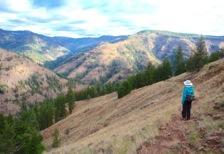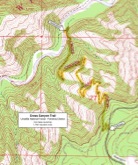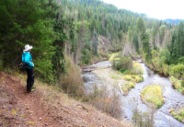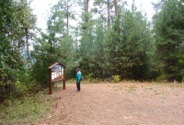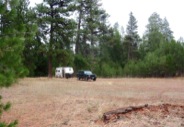Less Traveled Northwest
Day Hikes for the Adventurous
Cross Canyon Trail
NOTE: The Cross Canyon Trail burned in Grizzly Bear Complex Fire of September 2015. It may be a few years before this area recovers for recreational use.
Hike Rating: Moderate
Hike Length: 5.6 miles roundtrip
Elevation Loss: 1,750’
Trailhead Elevation: 4,100’
Best Season: June through September
Driving Access: Any vehicle
Plus Points
• A scenic hike that starts on the rim and ends on the shady banks of the Wenaha River
• The entire hike is within the Wenaha-Tucannon Wilderness Area
• Sweeping, panoramic vistas up and down the river canyon at every step
• Trail traverses both dry, south-facing slopes and forested, north-facing slopes
• Grouse (both roughed and blue) in the forests; bald eagles along the river
• Possible sightings of Shiras moose along the river floodplain
Minus Points
• Hike can be brutally hot in mid-summer, so plan to start in early AM on hot days
• Rattlesnakes are commonly encountered throughout the summer, so be aware
Download (PDF, 765 KB): Photos of Cross Canyon Trail
Download (PDF, 713 KB): Topo Map for Cross Canyon Trail
Download (PDF, 729 KB): Road Map for Cross Canyon Trail
Trail Notes
From the trailhead on Road 6217, the trail drops steeply downhill for about 50 yards to the Wilderness boundary. It then begins a long, gradual descent to the north through pure stands of western larch. At about 0.3 miles, as the trail emerges from the trees and switchbacks southwest across an open slope, one has the first of many panoramic vistas across the Wenaha River canyon and into the Butte Creek watershed beyond.
For the next 1.5 miles, the trail switchbacks back and forth down the hillside, traversing dry, open, south-facing slopes and moister, north-facing slopes with mixed stands of douglas fir and larch. In between, the forest transitions to scattered ponderosa pine and even juniper on the very driest rock ridges. Overall, the trail is well-built on a good grade, but has several stretches with loose rock underfoot, so take care in these sections. At 1.8 miles, the trail makes its last big switchback and begins a gradual, half-mile descent north into the river bottom.
As one descends, the hillside fir forests become denser with a thick understory of spirea, thimbleberry and maple. For the first time, one can hear the roar of the river below and glimpse the rushing water through the trees. Look for bald eagles cruising over the tall, streamside cottonwoods. At 2.5 miles, the trail reaches the river floodplain and a trail junction. Taking the right (north) fork, one can wander down the floodplain for a half-mile, through scattered firs to wide gravel bars at river's edge. Taking the left (south) fork, one arrives at the river bank within 300 yards, under steep cliffs and big douglas firs. Take time to explore the river bottom, have lunch, then return as you came.
Road to Trailhead
On gravel Road 62, about 17 miles west of Troy and 4.0 miles west of the Long Meadow Guard Station, look for Road 6217 branching off to the right (north). If coming from the west on Road 62, the turnoff is about a mile east of the (unsigned) Big Hole Overlook. Turn north on Road 6217 and drive about 2.7 miles to the trailhead, at a vault toilet on the left (west) side of the road. This trailhead is easily accessible by any passenger car.
Camping Options
There are no developed campgrounds within easy commuting distance of the trailhead, so dispersed camping with one's own water and sanitation is the best option.
For tent campers: There are 3-4 dispersed campsites on the 2.7-mile drive along Road 6217 to the trailhead. These are on spur roads leading off Road 6217 that have been closed, but still with enough room to set up camp and have privacy from the road. Water is available at a piped spring and trough about 30 yards downhill from the trailhead.
For all campers: A good area for dispersed camping, known as Mosier Spring, is just off Road 62 about 0.2 miles west of its junction with Road 6217, and about 3 driving miles from the trailhead. On dirt Road 190 leading south off Road 62, one comes to a fork in about 0.1 miles. Camping trailers should take the left fork to a turnaround and 3-4 camping spots under big firs and ponderosas. Tent campers can take either fork and look for grassy sites in the open or in the trees. However, to avoid getting stuck, make sure the soils are dry before driving off Road 190. Water is available at a piped spring and trough at the end of the right-hand road fork, just downhill from an old stone chimney.
Finally, a third spot for dispersed camping is off Road 62, about 0.9 miles west of the Long Meadow Guard Station, and about 6 driving miles from the trailhead. On both sides of Road 62, there are short spur roads leading off to camping sites under large firs and ponderosas. The area is quite scenic, but there's not much privacy from the main road.
Agency Contact: Umatilla National Forest, Pomeroy District, (509) 843-1891
DISCLAIMER: Every effort has been made to ensure the accuracy of this information, but the authors do not guarantee that it is either current or correct. The reader assumes full responsibility for any use of this information, and is encouraged to contact local public land agencies to inquire about current conditions before traveling.
Page last updated: 11/23/13

